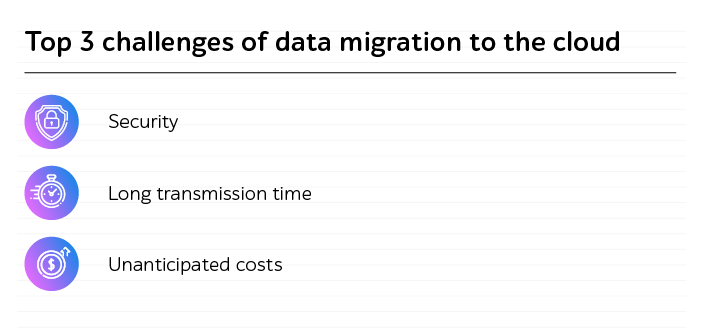
Data migration to the cloud: enable robust transition through QA
In line with digital transformation, the demand for new technologies is growing by leaps and bounds. Businesses are geared towards more independence in the IT sphere, so it’s no longer enough just to support the product – its advancement is a big deal.
One of the ways to suit the requirements of the rapidly evolving market is data migration to the cloud with a secure and well-tuned transfer process at the helm. Otherwise, it can trigger severe repercussions for both production and company.
In this article, we will unveil topical quality issues of data migration and unleash cloud testing potential for business development.
Is it worth starting data migration to the cloud?
Prompt tech market evolution forces businesses to harness new technologies and strengthen their IT apps.
By using cloud computing, organizations not only streamline workflow but also get additional competitive perks. We’ve put together 5 advantages the business can gain in this case.
- Round-the-clock access. Now employees are not strictly dependent on the office as cloud storage allows working at any time and any place leveraging 24/7 ecosystem availability.
- Total scalability. By choosing cloud, companies can up- or downscale their computing resources thus adjusting the services depending on their needs and objectives.
- High data security. Concomitant process security is noteworthy as information can be restored easily due to data backup.
- Accelerated adoption. Software and hardware resources can be reconfigured into new information systems and business services in less than no time.
- Cost-effectiveness. Companies pay only for the services and capacity they use. There is no longer a need to purchase special equipment and applications for the maintenance of a data center.
Since you have dealt with a cloud provider, you don’t need to hire technical support specialists providing reasonable budget allocation.
Remember it’s not a walk in the park
Despite all that said, data migration can be risky and stressful.
A solid and comprehensive strategy should be built in advance. All points are to be covered, starting from choosing a cloud provider and ending with data transferring. Profound knowledge of all migration steps can help IT managers eliminate business risks and losses.
Another silver bullet is data integrity. A comprehensive supervising of data transfer ensures its accuracy and consistency to avoid possible future misunderstandings.
The biggest issue in moving data to the cloud is the security of the transfer process. The threat of losing access to information and data breach owing to high susceptibility to various attacks may emerge.
Long transmission time is another challenge. It is not easy to predict how much time data migration can take. The connection speed may slow down due to network problems and hardware limitations.
Because of improper planning, many organizations’ budgets suffer from unanticipated costs. According to the Flexera report, respondents estimated expenditures at 27%, while experts suggested – 35%. Data should be divided into parts and migrate gradually, so you need to consider that beforehand where the data will go, to what extent, and in what order.

Salvage transition with cloud testing
Companies gather information for decades, and when the data migration time comes, its volume may be unprecedented. Thorough testing can ascertain the quality of the delivered product and ensure that sensitive information won’t leak.
Business needs and project peculiarities determine the choice of a particular testing service.
Functional testing
The engineers review feature by feature and verify whether it complies with the set requirements, integrates seamlessly with the corporate environment, and meets users’ expectations. Also, they check the correct operation of API, data connections, and all information in new storage for compliance with a previous one.
Test automation
By leveraging its best practices, QA specialists scan internal and external vulnerabilities and evaluate compliance with set standards optimizing resources, easing the workload, and eliminating the human factor.
Security testing
IDC’s survey showcases nearly two-thirds of organizations see security as the biggest challenge for cloud adoption with prevailing hacker attacks.
Solid data protection may be enabled by harnessing more powerful software. However, occasionally users uncover their credentials by accident so that the responsibility falls on the company. Two-factor authentication assuming several steps of login can help avoid such cases. For instance, firstly utilize username and password, secondly — a special code sent over SMS.
Security during data transmission is one more layer of cloud protection. Reliable providers should use traffic encryption with HTTPS protocol and SSL certificate to prevent data interception.
Performance testing
The team examines the virtual environment for its resilience to stress and load, endurance, and network latency to detect weak points in its capacity and scalability.
Denial-of-Service attacks (DoS) are common among malicious users. Multiple simultaneous requests to the computer system force it to use a huge amount of resources that eventually cause server overload. Thus, customers are cut out of using the cloud service. Distributed or DDoS attacks are more frequent and are executed from multiple points. Organizations rarely can withstand them.
Only a cloud vendor can assist in setting necessary protection tools and services. Having numerous data channels with a high bandwidth that are geographically dispersed, the cloud provider counteracts to malicious activities. The company filters the traffic using special analyzers and then delivers legitimate traffic to the client’s service.
Bottom line
A shift to data storage in the cloud became an across-the-board need within the advent of the informational age. It brings a range of benefits, including access from any location, cost-effectiveness, and scalability. On the contrary, its implementation is rather challenging and requires investments, including time and money.
A solid transfer plan, comprehensive cloud testing, and providing a high level of security can allow you to be confident in new storage format and information privacy.
Need consultation on data migration? Feel free to contact our experts.








